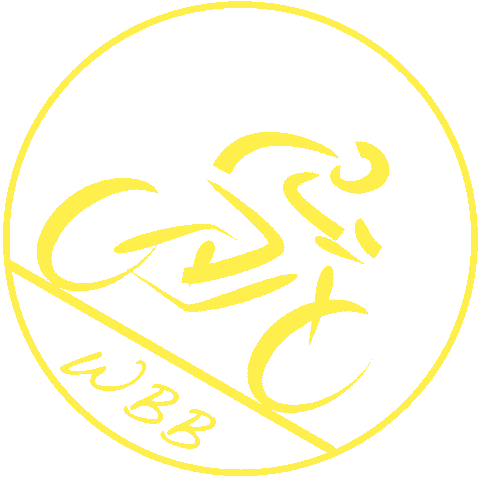Velodrome Basics
This page gives you a detailed tour around velodromes, using the two indoor velodromes in Ontario as examples:
- Mattamy National Cycling Centre in Milton. This was the 2015 Pan AM Games velodrome, Its a UCI Class 1 velodrome, one of only two in North America
- Forest City Velodrome in London Ontario. This is the smallest permanent indoor velodrome in the world, and incredibly fun to ride.
The Milton Velodrome, conforms to the dimensions of a UCI Class 1 velodrome: a 250-metre long, 7-metre wide timber track constructed from smooth, untreated Siberian Spruce, with 42-degree banked bends and 13-degree banked straights. Check out the view of the track below:

A View of the Milton Velodrome
Looking from the top of the banking along the finishing straight

Standard Velodrome Markings
This diagram shows all the markings on a 250 meter track
The track is divided into sections as follows:
- The infield of the track is the gathering place used when getting ready to ride, and after riding. In a multi-use facility, like the Milton Track, the infield will also be used for basketball, vollyball, badminton, and other gym sports. The infield is a great place to hang out and socialize with other riders and coaches. Hanging out here is definitely encouraged!
- The safety zone is not part of the track surface. Its used to “roll-out” to get up to speed to enter the track, and to cool down after riding. Its important not to obstruct the safety zone, and when on the safety zone to ride slowly, and as far away from the track surface as possible.
- The cote d’azur, or just “cote” for short, is the cyan colored (hence its name) part of the track surface which is used to transition onto and off of the track. Its not considered part of the track proper. Don’t ride on the cote, except when getting on and off the track, and make your time on the cote as short as possible.
- The black “datum” line is twenty centimeters (20cm) above bottom of the track. Its 5cm wide, and its inside edge defines the actual length of the track. The black line is marked every 5 meters and numbered every 10 meters.
- The red “sprinters” line is 90cm higher up again. Between the red and black lines (referred to as the “sprinter’s lane), riding as close to the black line as possible, is the shortest and most efficient path around the track. Once a rider is racing in this zone, anyone wishing to pass them must go around above them, one can’t try to push a rider out of the lane, cut down on them, or try to pass below. This is also true in recreational track cycling - one never ever passes below a rider who is riding at the red line or lower. Always pass above.
- The blue “stayer’s” line is about one-third the width of the track from the bottom. This line is used for specific racing events such as the Madison or motor-paced events. During recreational track use, pace lines of riders will form at either in the sprinter’s lane, or at the blue line. Faster lines ride on the blue, slower lines inside red. The slower sprinter’s lane riders never go above the blue, even when passing or exchanging. The faster blue line riders never drop below the blue.
- At the Forest City Velodrome (see below) there is also a yellow warning line at the top of the track. One should not ride above this line.
A 250 meter UCI class 1 track also has the following lines:
- The main start/finish line is a black line, surrounded by white bars that across the track at the end of one of the straightaways, a few metres from the start of the bend.
- Red lines running across the track on opposite sides halfway along each straightaway mark the start-finish lines for pursuit events.
- A thin white line in the middle of the first banking, 200m from the finish line, marks the start of the length used for Sprint qualifying (200m flying lap)
- Another thin white line in the first part of the final banking represents 100m to the finish line.

Forest City Velodrome Track Surface
Forest City Velodrome by comparison is 138 meters in length, with 51-degree bankings, 17-degree straights, and a much narrower track surface. The surface is plywood. Here’s a couple of views of the facility:

Forest City Velodrome
Overview of the facility from the stands

Forest City Velodrome
View from the middle of the infield, looking towards the final banking
There are also outdoor velodromes, where 333.3 meters and 400 meters are common sizes. In addition to wood, outdoor velodrome surfaces can also be concrete or asphalt. Over time, the standard track length for international competition has shortened from 333.33m to 250m. The web sites for most velodromes will include an overview of velodromes, and a detailed description of their tracks. For a list of velodromes around the world, see Wikipedia’s list of velodromes
